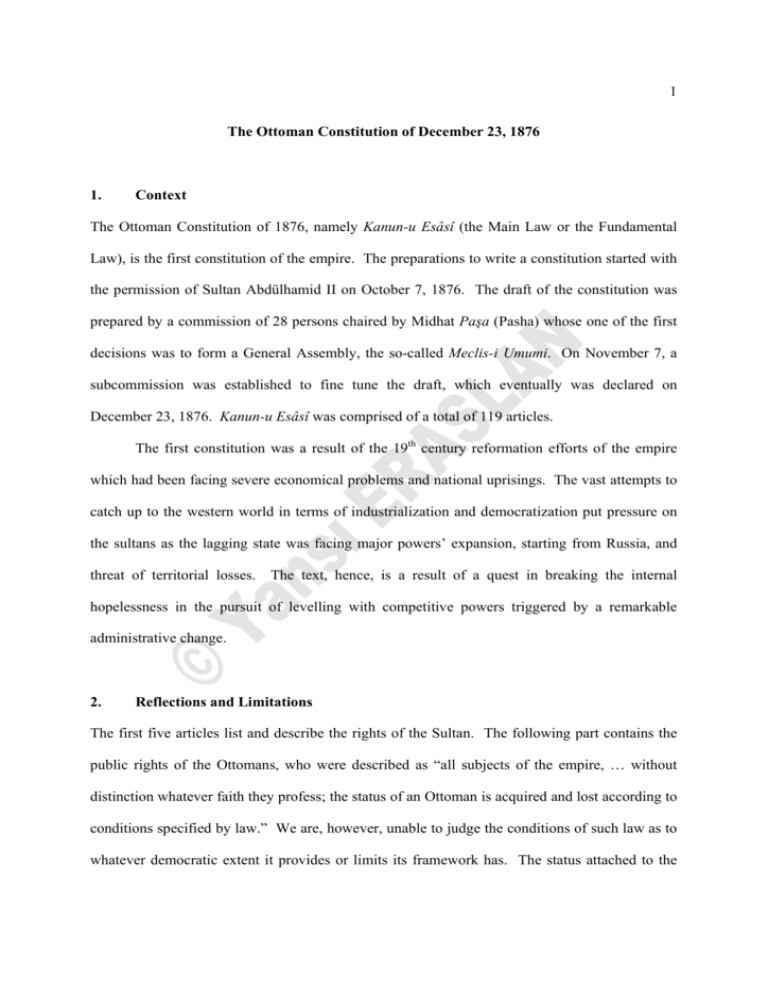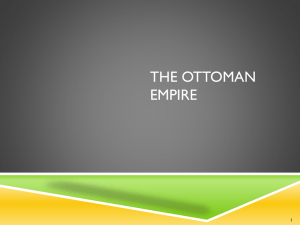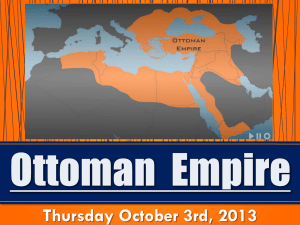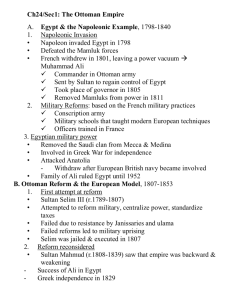1 The Ottoman Constitution of December 23, 1876
advertisement

1 The Ottoman Constitution of December 23, 1876 1. Context The Ottoman Constitution of 1876, namely Kanun-u Esâsî (the Main Law or the Fundamental Law), is the first constitution of the empire. The preparations to write a constitution started with the permission of Sultan Abdülhamid II on October 7, 1876. The draft of the constitution was prepared by a commission of 28 persons chaired by Midhat Paşa (Pasha) whose one of the first decisions was to form a General Assembly, the so-called Meclis-i Umumi. On November 7, a subcommission was established to fine tune the draft, which eventually was declared on December 23, 1876. Kanun-u Esâsî was comprised of a total of 119 articles. The first constitution was a result of the 19th century reformation efforts of the empire which had been facing severe economical problems and national uprisings. The vast attempts to catch up to the western world in terms of industrialization and democratization put pressure on the sultans as the lagging state was facing major powers’ expansion, starting from Russia, and threat of territorial losses. The text, hence, is a result of a quest in breaking the internal hopelessness in the pursuit of levelling with competitive powers triggered by a remarkable administrative change. 2. Reflections and Limitations The first five articles list and describe the rights of the Sultan. The following part contains the public rights of the Ottomans, who were described as “all subjects of the empire, … without distinction whatever faith they profess; the status of an Ottoman is acquired and lost according to conditions specified by law.” We are, however, unable to judge the conditions of such law as to whatever democratic extent it provides or limits its framework has. The status attached to the 2 constitution, being an Ottoman, seems to be a terminology which does not manifest “citizenship” with explicit definitions but rather demonstrates a “subject” of the empire, where the Ottoman sovereignty belongs to the eldest Prince of the House of Osman. Albeit its undemocratic appearance, when the underlying factors of the article are considered, it is far from being unique particularly within the 19th century continental Europe; at the very least, the constitution gives such status to all irregardless of their faith, which is relatively a liberal understanding in embracing the freedom of conscience. The latter is also warranted under the 11th article which asserts that “the state will protect the free exercise of faiths professed in the Empire, and uphold the religious privileges granted to various bodies”, and under the 17th article that grants the same rights and provides equality in the eyes of the law to all Ottomans regardless of their religious preferences. The 9th and 10th articles emphasize the personal liberty, which is wholly inviolable, on the conditionality of non interfering with the liberty of others. They also smash the link between randomness and punishment, which is critical for that particular era’s conditions during which individuals could face discretionary sanctions as a result of severe imbalance of power between the state and the individual. Such randomness is also prevented by article 20, which calls for the assessment and distribution of the taxes in proportion to the fortune of each taxpayer. In terms of judicial independence and order of law, Kanun-u Esâsî brings a number of improvements for a period where the structure of the relationship between the leadership and the followers are but significantly asymmetrical to the favor of the ruler. The constitution grants each person, in the interest of his/her defence, to make use of the means before the tribunal and it strictly forbids torture and inquisition under any form. Not only does it provide transparency by requiring the sittings of all tribunals public except from specified cases by law, but also it prohibits any interference to be attempted with the tribunals. 3 The constitution regulates the establishment of the General Assembly where the members are free to express their opinions and to vote as they like. The text acknowledges that the members of the General Assembly neither cannot be prosecuted for opinions or votes delivered in the course of debate, nor be bound by conditions or promises or even be influenced by threats. It should be mentioned that even such a mild political transition from tight monarchy to a constitutional one was unthinkable given the democratic climate of the time. Nevertheless, this transition was discontinued when the Sultan abolished the General Assembly only a year after by exercising his constitutional prerogatives on the grounds that he was personally held accountable for the defeat in Ottoman-Russian war. The formation of the lower house of the General Assembly, namely Meclis-i Mebusan, demonstrates a discriminatory structure as the number of members in the house was determined as a proportion to the total number of Ottoman adult males, numerically one member for every 50,000 men. The members of the upper house, the so-called Heyet-i Ayan resembling to the senate of the modern era, on the other hand, were to be appointed directly by the Sultan for lifetime. Last but not least, one of the major weaknesses of the text was the expansive sovereign rights of the Sultan. Article 113 grants the imperial government the right to proclaim a state of siege, dependent upon “the perpetration of acts or the appearance of indications of a nature to presage disturbance at any point on the territory of the Empire”, during which the civil laws are temporarily suspended. Moreover, the Sultan was given the exclusive right of expelling those who were recognized as dangerous to the safety of the State, merely with trustworthy information obtained by the police; indeed, this very article was the justifying line of the text in Sultan’s ejection of Midhat Paşa later. 4 3. Historical Background and Conclusions The first constitution of the Ottoman Empire has various limitations starting from citizenship to very broad prerogatives granted to the Sultan; nevertheless, the historical conditions of the time display that even sharing a limited authority of the Sultan was extraordinary, a slightest transparency or accountability was improbable, and moreover, the mere idea of formation of an Assembly under the authority of the ruler was beyond the expectations. The structure and the formation of the constitution -such that it did not emerge as a result of a revolution- made it fairly distant from the contemporary definitions of democracy. Whereas it provides some signs of Robert Dahl’s criteria with regards to representative democracy such as elected officials, still with limitations in terms of nondiscriminatory basis, and free, fair, and frequent elections -in spite of our lack of information on universal suffrage-, it is hard to argue that the era’s political institutions were mature enough to claim for a self-sustainable democracy. The administrative features and historical facts demonstrate that freedom of expression was no more than an ideal, criticism of officials or the government was merely a utopian suggestion, access to alternative sources of information and the idea of free press were too optimistic, and independent political parties and interest groups were inconceivable. Yet, Kanun-u Esâsî, despite various democratic shortfalls, still succeeded in preparing raising a generation who would then aim to establish westernized democratic institutions in lieu of religious fundamentals. It was also a major sign of internal movement from within the society and intellectuals as a recipe to rescue the empire, as opposed to the earlier examples of reformation attempts demanded by the rulers, demonstrating a top-bottom approach.







